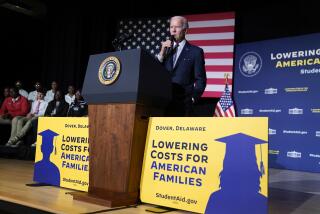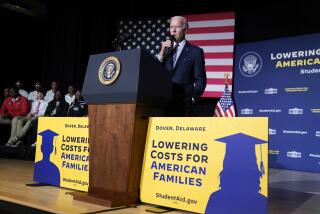A Wall Street solution on student loans that benefits (surprise!) the rich

USC commencement last May: Who’ll pay the bills?
The student debt crisis is sufficiently horrific to have generated a plethora of ideas for relief, from refinancing government loans to make them more affordable (Sen. Elizabeth Warren [D-Mass.]) to making all higher education tuition-free (thank you, Sen. Sanders).
A team of conservative economists from the American Enterprise Institute has been promoting a market-based plan known as Income Share Agreements. The idea is that investors would offer students loans to be paid back from a set percentage of their future earnings over a set time frame, setting the terms and interest rates on the loans according to their view of the students’ likely future income.
The beauty part, according to the market fans at AEI, is that investors would be inclined to put their money on students at the best schools and programs with the most potential to generate high incomes for graduates. Win-win. Engineers or software programmers at good technology universities would get better terms than, say, cosmetology students at rural diploma mills.
“ISAs are better suited for student financing than traditional student loans,” AEI declares confidently, but that’s far too categorical a statement.
They’ve been challenged on a couple of counts by liberal economist Mike Konczal of the Roosevelt Institute. Much of his debate with AEI concerns whether such loans will contain the increase in college costs (AEI says yes, he’s skeptical.) That’s the less interesting issue, because the impact of lending programs on college costs is ... well, inconclusive.
More interesting is Konczal’s argument that ISAs wouldn’t work so flawlessly to support students in promising programs at good schools. Logic and experience say he’s got the better end of the debate.
“Risk-based” student loans aren’t a new idea. Among those who have promoted it are Michael Simkovic of Harvard Law School, in a 2011 paper. Repayment plans tied to post-graduation income are already available to borrowers of federal student loans--the student pays 10% of income for a set period, after which the remaining balance is forgiven. (Terms are better for students going into public service or nonprofit employment.)
To this model, Andrew Kelly and Kevin James of AEI add the element of investor underwriting. The lenders, or investors, would make more if they funded students at good schools or good programs, so they might give those students a break. “Investors have incentives to tailor the terms they offer students to the expected value of the different programs,” they write.
Computer science students at, say, Stanford might only have to pay 4% of their income, because investors figure they’d be slotted in to the vibrant Silicon Valley market; sociology students at Rabbithash State might be charged 10%. This would also encourage schools to offer programs with the highest expected returns, another benefit of Mr. Market.
The big flaw Konczal identifies here is that differences in university programs “are a determinant of future income, but they are only a minor one. Family income, occupation, race, and gender are going to be much more important to the calculation.”
As evidence, Konczal points to a finding from the Pew Charitable Trust’s Economic Mobility Project (see accompanying graphic, via Matt Breunig). It shows, among other things, that “those born in the top 20 percent who don’t have a college degree are two and a half times more likely to end up in the top 20 percent than people born in the bottom 20 percent who do have a college degree.”
In other words, “a white male born rich who attends a bad school will get significantly better equity pricing than a woman of color born poor who attends a better school, because the former will have a higher expected future income.” The rich will get richer.
AEI asserts that profit-seeking investment funds will be only one category of lender. “Other funds may be established on more altruistic grounds,” for example nonprofit funds to assist minority students. This sounds like window-dressing--if you propose a program to exploit market mechanisms, it doesn’t help your point to claim that the effect can be mitigated by funds immune from market concerns.
One point not raised by Konczal is that this system would place a pretty large responsibility on investors’ judgments and their interests. They’d be betting now on where demand will be over the next ten, 20, or even 30 years. Their judgment is certain to be narrow--humanities programs would surely be shortchanged--and may be wrong.
Investors today would place all their bets on science, technology, engineering, and math (the STEM fields), but those fields experience boom-and-bust cycles and there are signs that the current market already is oversupplied. It’s easy to imagine investors with billions tied up in students in certain fields--their “assets”--lobbying for government programs to make sure they stay employed until their loans are paid off. Do we really need to give hedge funds another reason to foster economic inequality, or to manipulate their pet legislators?
There may be a role for such programs, whether they’re called “risk-based lending,” “human capital loans,” or “income share agreements,” but it’s only a role. A panacea for the student loan crisis they’re not. AEI has the glimmer of a good idea, but it needs to go back to the drawing board.
Keep up to date with the Economy Hub. Follow @hiltzikm on Twitter, see our Facebook page, or email michael.hiltzik@latimes.com.
More to Read
Inside the business of entertainment
The Wide Shot brings you news, analysis and insights on everything from streaming wars to production — and what it all means for the future.
You may occasionally receive promotional content from the Los Angeles Times.











